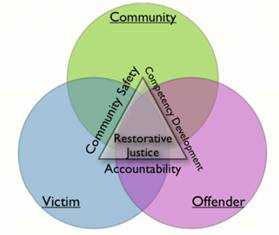by Caleb Ratzlaf, CCJC 2010 Intern
As a restorative justice advocate living with a number of students working on Parliament Hill at the Laurentian Leadership Center (A Trinity Western University Program), I’ve had opportunities to hear a many arguments opposing my perspective on criminal justice.
In this article I’ll respond to some of the common arguments against restorative justice.
1. It is widely believed that alternatives to incarceration will increase bureaucracy, compounding ineffectiveness and ballooning expenses.
In reality, the opposite has proven to be the case. In 2005-06, the annual average cost of keeping an inmate in a Canadian penitentiary was $88,067 per year, up from $80,780 per year in 2001-02. It costs substantially less to maintain an offender in the community: $23,105 per year , with comparable or better outcomes.
2. In Canadian society there is a widespread perception that crime is on the rise.
Last year some 44% of Canadians thought crime rates had increased in the past five years. Where these ideas originate is not easily located, but they all stem from unwarranted fear. Currently crime in Canada is at a 25 year low and declining. It’s true, as some have argued, that crime in Canada is still unacceptably high; however, we should question the increase in rates of imprisonment given the steady decline in the national crime rate.
3. Opponents of restorative justice have voiced the concern that victims are repeatedly re-victimized in restorative justice practices.
Research indicates that RJ practices meet the emotional and informational needs of victims, and assist in the healing process to a much fuller extent than the traditional court system. Additionally, RJ practices like victim offender mediation are typically voluntary and adaptable to victims’ needs.
4. It has been argued that victims should be kept out of the justice process because they are emotionally tainted and out for vengeance.
This sentiment is a direct contradiction to the experience of Steve Sullivan , the former federal ombudsman for victims of crime in Canada. After numerous encounters with victims he stressed that they do not want vengeance or cruelty. Victims have a strong desire to be heard, to be acknowledged and to be safe. In fact, Mr. Sullivan made it clear that a victim’s primary goal is not punishment but rather when offenders re-enter society, that our system does everything it can to make sure that they won’t reoffend.
The Church Council on Justice and Corrections strongly believes that in order to ensure security and longevity of restorative justice initiatives, the government needs to create legislation that would make room for a parallel sentencing process focused on restorative justice initiatives like Circle of Support and Accountability and the Collaborative Justice Program. This will require a shift from a purely punitive system, in which punishment is the only option, to a focus on restoring and strengthening communities.
We need a justice system that encourages offenders to take responsibility for their actions, addresses the healing needs of victims, and which provides adequate rehabilitation programs to make sure that the cycle of crime is truly broken. There is significant evidence that victims, offenders and their communities’ benefit more from an approach to justice that emphasizes responsibility, reparation and restoration.

